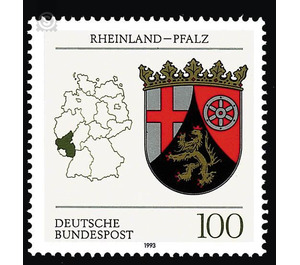Coat of arms of the Land of the Federal Republic of Germany (2) - Germany / Federal Republic of Germany 1993 - 100 Pfennig
Theme: Art & Culture
| Country | Germany / Federal Republic of Germany |
| Issue Date | 1993 |
| Face Value | 100.00 |
| Color | multi-colored white |
| Perforation | K 13 3/4 |
| Printing Type | Multicolor offset printing |
| Stamp Type | Postage stamp |
| Item Type | Stamp |
| Chronological Issue Number | 1537 |
| Chronological Chapter | GER-BRD |
| SID | 188922 |
| In 46 Wishlists | |
The coat of arms of the three most important historical territories, the Rhineland-Palatinate states of Trier, Mainz and Palatinate, combines the coat of arms of the Rhineland-Palatinate coat of arms of 1948 into a shield divided into three fields by an inflected point. The red cross in silver is the coat of arms of the archdiocese and electorate of Trier. It first appeared in 1273 in the seal of the Archbishop Henry II and represented the state until the secularization 1803. The six-spoke silver wheel in the red field represents the archdiocese and electorate of Mainz. Its creation is legendary. A popular legend relates it to the Archbishop Willegis (975 - 1011), allegedly the son of a Radmachers, in which his opponents painted wheels on the door and reproached him with the saying: "Willegis, think, where you came from! Other attempts at interpretation derive it from the Christ monogram (XP, the Greek Chi-Rho) or want to trace it back to Celtic or Germanic solar symbols. It is more likely that the wheel is an attribute of St. Martin, the patron of the oratory, is or symbol of the gospel and the church in the style of the vision of the prophet Ezekiel. Initially, it appeared as a double wheel, so on coins of Archbishop Siegfried III. (1230 - 1249) and still today in the coat of arms of the state capital Mainz. Later it was simplified to a wheel. It spread because of the widely dispersed territorial possession of the archdiocese over large parts of Germany, where it is still represented today in the coats of arms of many cities (for example, Erfurt). The Palatine lion, golden with red crown and reinforcement in the black field, is first to be proven under the Wittelsbach Count Palatine Otto the Illustrious in its rider seal of 1229. However, he is probably older and presumably goes back to the 11th to 1214 ruling Welf Palatine. He remained common coat of arms of the widely ramified Palatine lines and survived the end of the state in the Bavarian district coat of arms of the Palatinate and in the regional coats of arms of Bavaria and the Saarland. (Text: Rhineland-Palatinate, State Chancellery, Mainz)


